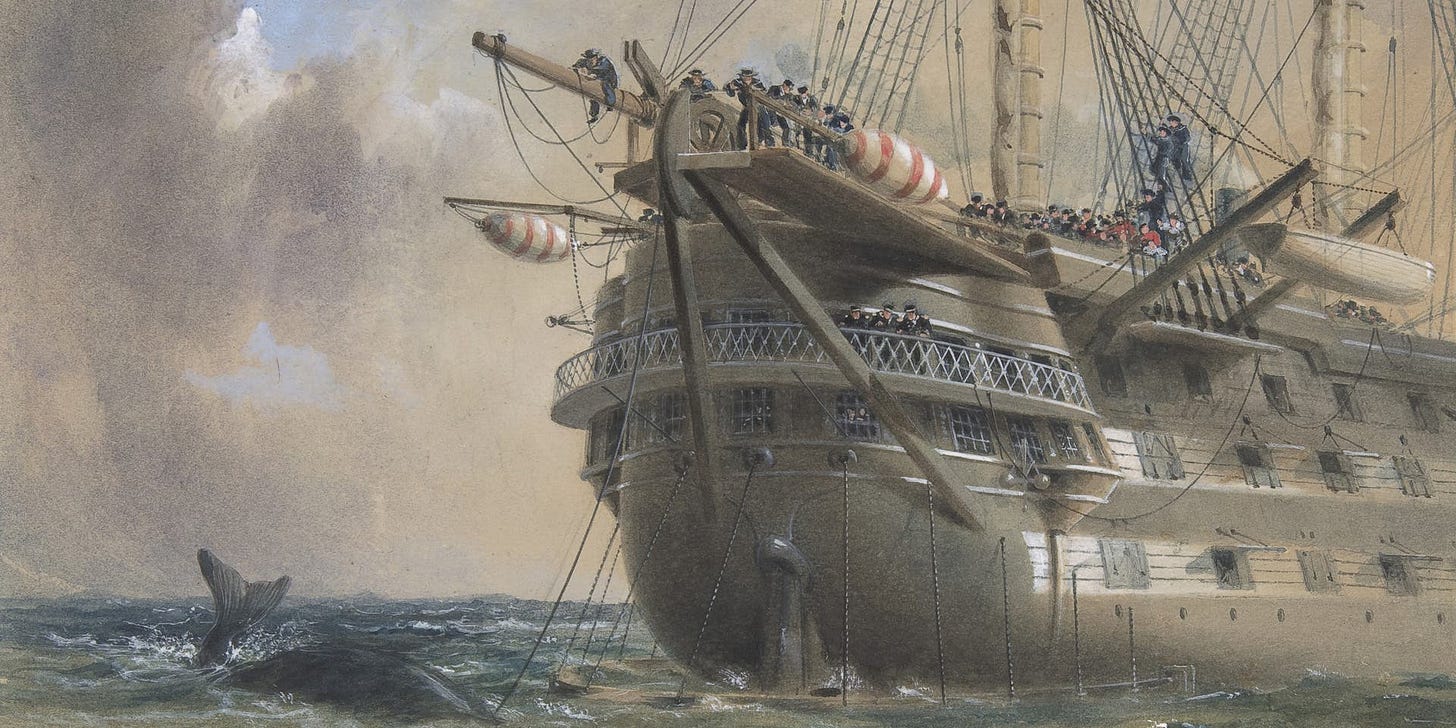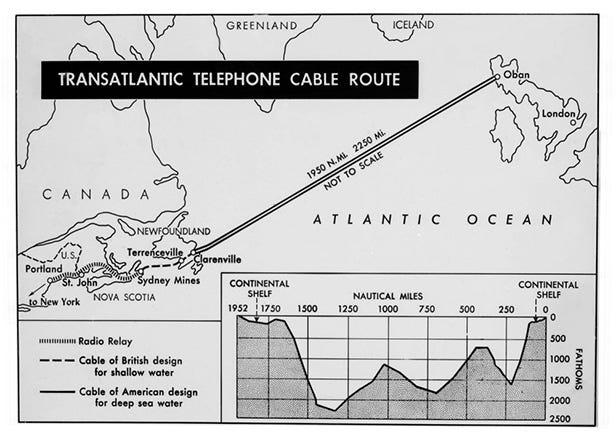Wonders of our World #3: Undersea Cables
How the network of marine fiber optic cables represents a triumph of technology and a chokepoint for the world's data.
Today, I want to revive the Wonders of our World series and talk about something that I think deserves more recognition and appreciation: the world's undersea telecommunications cable network. These cables carry more than 95% of international data traffic, enabling global communication, commerce, and collaboration. They are the backbone of the internet and one of the world’s most impressive feats of human engineering.
But how did this network come to be? How does it work? And why do I think it deserves the #3 spot in my list of modern "world wonders" alongside the legendary infrastructure projects like the Chinese Grand Canal, The Delta Works, or the worldwide weather satellite network? Let's find out.
History
The history of undersea cables dates back to the 19th century, when the first telegraph cable was laid across the Atlantic Ocean in 1858. It took several attempts and years of trial and error to make it work reliably, but eventually it enabled near-instant communication between Europe and North America. This was revolutionary, and over the next decades, more cables were laid across other oceans and regions, creating a global telegraph network that revolutionized politics, business, and society.
The first transatlantic telephone cable was installed in 1956, allowing voice calls between continents. It used coaxial copper wires that could carry 36 simultaneous calls. The capacity and quality of these cables improved over time, but they were still limited by the need for electrical amplification every few hundred kilometers. This made them expensive to install and maintain, and meant the network was relatively unreliable.
The breakthrough came in the 1980s, when fiber-optic technology was introduced. Fiber-optic cables use pulses of light to transmit data through thin strands of glass or plastic. They have several advantages over copper wires: they can carry much more data (thousands of times more), they are immune to electromagnetic interference, and they require less amplification (only every few thousand kilometers). These features made fiber-optic cables cheaper, faster, and more reliable than their predecessors.
The first fiber-optic cable across the Atlantic was laid in 1988. It had a capacity of 280 megabits per second (Mbps), equivalent to 40,000 phone calls. Since then, the capacity and number of fiber-optic cables have increased exponentially, following Moore's law. The latest generation of cables can carry up to 400 gigabits per second (Gbps) per wavelength, and use multiple wavelengths to achieve terabits per second (Tbps) of total capacity. For comparison, the average broadband speed in the US is about 100 Mbps.
Present Day

Today, there are more than 400 undersea cables in operation, spanning over 1.2 million kilometers (about 745,000 miles) of ocean floor. They connect every continent except Antarctica (although there are plans to change that). They are owned and operated by a mix of governments, telecom companies, internet giants like Google and Facebook, and consortiums of various stakeholders. They cost hundreds of millions of dollars to build and require specialized ships and equipment to lay and repair them.
The cables are made of several layers of material that protect them from water pressure, abrasion, and marine life. At the core are the optical fibers - strands of ultra-pure glass as thin as a human hair, encased in a layer of plastic. Surrounding this core are concentric layers of steel and aluminum for structural reinforcement and a polyethylene outer sheath for further insulation and protection.
Data is transmitted through the fibers in the form of light pulses generated by lasers. These pulses represent binary digits (bits), the fundamental units of digital information. A single fiber can carry multiple wavelengths (colors) of light simultaneously, using a technique known as wavelength-division multiplexing. This, combined with advances in modulation schemes and error correction, allows modern cables to transmit tens of terabits of data per second over thousands of kilometers with minimal loss.
However, even with these advanced technologies, the cables are not immune to damage. They face threats from fishing nets, ship anchors, undersea landslides, and even shark bites. That's why they are carefully routed to avoid busy shipping lanes and geologically unstable areas, and buried under the seabed near shorelines. They also have repeaters every 50 to 100 kilometers to boost the signal and compensate for loss.
In addition to the technical challenges, the creation and maintenance of the undersea cable network involve complex economic and political issues. Famously, the U.S. tapped into and monitored a Soviet communications cable off the coast of Kamchatka during operation Ivy Bells, to intercept orders between the Kamchatka-based strike force and a Soviet naval HQ in Vladivostok. Their method of wiretapping was especially creative, because it required no interruption to the cable’s operation. Instead, their monitoring device wrapped around the existing cable, and detected changes in its electromagnetic field in order to siphon communications data into the hands of U.S. intelligence.
Building a cable requires large upfront investments, long-term planning, international cooperation, and careful risk management. It's a classic example of a public good that benefits everyone but is costly for individual entities to provide. For most of the history of undersea cables, they were financed by consortia of telecom operators, who shared the costs and revenues. Recently, though, authoritarian regimes like Russia and China have invested heavily into state sponsored networks either directly building their own cables or taking control of the companies that do so.
Looking Ahead
Large tech companies like Google and Facebook have begun to outpace the traditional telecom companies, and started to invest in their own cables to meet their increasing data needs and gain more control over their global networks. This trend shows the growing importance of data and digital infrastructure in the global economy, and the shift of network power from traditional telecom operators to the tech giants whose data makes up large shares of network traffic.
For example, the TAT-14 (The 14th consortium-built Trans-Atlantic Telecommunications Cable) was recently decommissioned in 2020, and was the first transatlantic cable to be replaced since the Gemini cable in 2003. It had a capacity of 9.48 Tbps, and spanned ~15.5km from the U.S. to the shores of various North-Atlantic countries.
This time, however things are different. The cable network replacing the TAT-14 is made up of 5 key component cables, and is called the North Atlantic Loop. The newest of these cables is the AEC-2 (America-Europe Connect) cable, which is able to transmit 108 Tbps. This, combined with the AEC-1’s capacity of almost 20 Tbps dwarfs the previous networks capacity. The AEC-2 has been invested in heavily by Facebook and Microsoft, and is no outlier when it comes to the growling trend of big-tech’s involvement in these projects.
The telecom growth spurt shown in the graph below has been driven by the rise of cloud computing and the growth in content provision as a service.
In 2022, the global market for submarine optical fiber cables was estimated at $22 billion. The market is projected to reach $30.8 billion by 2026, growing at a CAGR of 14.3%. Between 2016 and 2022, US tech behemoths, including Google, Meta and Microsoft, invested about $2bn in cables, accounting for 15% of the worldwide total. Over the next three years, they will pump in a further $3.9bn, or 35% of the total. Having accounted for less than 10% of total usage prior to 2012, content providers' share of total capacity surged to 71% in 2022.
As the global submarine cable network continues to grow, it’s important we keep in mind the double-edged nature of keystone infrastructure. Without proper redundancy and security, everything we build on top of these systems is at risk.
So why do I think the undersea cable network deserves the #3 spot in our list of modern "world wonders"?
First, it's a remarkable feat of engineering. The cables are marvels of materials science, optical physics, and marine engineering. The sheer scale of the network - spanning the globe, with cables as deep as Mount Everest is tall - is awe-inspiring.
Second, it's a testament to human cooperation and ingenuity. Despite the technical, economic, and political challenges, we have managed to create a global infrastructure that benefits everyone. It's a tangible manifestation of our interconnected world.
Third, it's essential for our digital economy and society. The cables enable global communication, commerce, and collaboration. They carry our emails, videos, financial transactions, scientific data, and much more. Without them, the internet as we know it would not exist.
Finally, it's a symbol of our dependence on unseen infrastructure and the natural world. The cables remind us of the physicality of the digital world, and its vulnerability to natural forces and human errors. They challenge us to think about the sustainability and resilience of our digital future. If we are to spend more and more time in increasingly virtual worlds, we’ll be dependent on others to maintain the infrastructure that supports those worlds.
For these reasons, I believe the undersea cable network is a modern world wonder. It's a story of human achievement, global interconnectedness, and the power and fragility of our digital age. I hope you have come to appreciate this remarkable infrastructure as I have. Tune in next time as we count down the list of modern world wonders with #2!
-Connor, Of All Trades.
Liked this post? Subscribe for more!
And if any of you readers out there are secretly crypto millionaires and would like to leave a tip, please check out https://alltrades.eth.xyz/








![Figure 1: Evolution of fiber-optic transmission capacity. The channel counts are estimated based on the product of amounts of wavelengths and spatial paths. The data of commercial systems (including symbol rate, optical interface, WDM capacity and submarine systems) are extracted from [1], [10] for 2000–2018 and from [11], [12] for 2019–2020. The lab research results are extracted from [13], [14], [15], [16], [17], [18], [19], [20]. WDM, wavelength-division multiplexing; SDM, space-division multiplexing; λ, wavelength. Figure 1: Evolution of fiber-optic transmission capacity. The channel counts are estimated based on the product of amounts of wavelengths and spatial paths. The data of commercial systems (including symbol rate, optical interface, WDM capacity and submarine systems) are extracted from [1], [10] for 2000–2018 and from [11], [12] for 2019–2020. The lab research results are extracted from [13], [14], [15], [16], [17], [18], [19], [20]. WDM, wavelength-division multiplexing; SDM, space-division multiplexing; λ, wavelength.](https://substackcdn.com/image/fetch/$s_!-NQO!,w_1456,c_limit,f_auto,q_auto:good,fl_progressive:steep/https%3A%2F%2Fsubstack-post-media.s3.amazonaws.com%2Fpublic%2Fimages%2F9c275492-dd52-4d42-8651-1e991fb5be46_975x732.jpeg)








I don't think these cables are a good example of a public good. They are eminently excludable; you can't transmit data on the cable if the owner doesn't let you, and it is easy to tell who is transmitting since they have to ask permission. The fact that most are built and owned by private companies who invest then collect the revenues seem to mark it as a standard high upfront cost industry.
They are also rivalrous, as your example of Google et al. building their own demonstrates, although at this point they are not so much rivalrous to individuals as they are for large data moving companies due to their huge capacity.